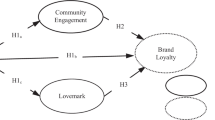Abstract
This case study looked at multiple sources of evidence to explore how a US furniture brand communicates its country-of-origin. The findings demonstrate that product-country and, in particular, product-place images remain relevant in both domestic and international brand marketing contexts. Although the brand does not tailor its communications for the global market, with its international audiences it relies on America’s reputation for status rather than on its domestic reputation of a heritage brand. While the recent made-in-America messages targeting domestic audiences subtly associate the brand with bringing jobs back to the United States, they primarily reinforce the ideas of local craft and quality. Narratives about heirloom-quality furniture handmade by craftspeople in a small town of North Carolina communicate a product-place imagery that not only sets the brand apart from its competition, but also appeals to craft consumers, at home and abroad, who express themselves by collecting or creatively using brands with unambiguous origin identities.
Similar content being viewed by others
References
Ahmed, S.A. and d’Astous, A. (2008) ‘Antecedents, moderators and dimensions of country-of-origin evaluations’, International Marketing Review, 25 (1), 75–106.
Ahmed, S.A. and d’Astous, A. (2011) ‘Product-country fit in the Canadian context’, Journal of Consumer Marketing, 28 (4), 300–309.
Askegaard, S. and Ger, G. (1998) ‘Product-country images: Towards a contextualized approach’, in, B.G. Englis and A. Olofsson (eds.), European Advances in Consumer Research, Association of Consumer Research, Provo, UT, pp. 50–58.
Campbell, C. (2005) ‘The craft consumer: Culture, craft and consumption in a post-modern Society’, Journal of Consumer Culture, 5 (1), 23–42.
Chrysler (2012) It’s halftime in America, http://www.youtube.com/user/chrysler/halftime-in-america, accessed on 30 March, 2013.
Deutch, J. and Steinfeld, E. (2013) Made in America, and everywhere else: Obama’s plans to revive US manufacturing run counter to the reality of global supply chains. The Wall Street Journal, 12 March, http://online.wsj.com/article/SB10001424127887324178 904578339863605169482.html, accessed 14 March, 2013.
Evans, G. (2012) Patriotism drives demand for Made-in-USA product. Furniture Today 13 August, p. 36.
Federal Trade Commission (1997) Enforcement policy statement on US origin claims, http://www.ftc.gov/os/1997/12/epsmadeusa.htm, accessed 29 March, 2013.
Furniture Brands (2012) 2011 annual report, http://www.furniturebrands.com/content/uploads/FurnitureBrands/AnnualReports/2011-Annual-Report.pdf, accessed 14 March, 2013.
Furniture Brands (2013) About us, http://www.furniturebrands.com/About-Us/Our-Company.aspx, accessed 14 March, 2013.
Ger, G., Askegaard, S. and Christensen, A. (1999) ‘Experiential nature of product-place images: Image as a narrative’, Advances in Consumer Research, 26 (1), 165–169.
Han, C.M. (1988) ‘The role of consumer patriotism in the choice of domestic versus foreign products’, Journal of Advertising Research, 28 (3), 25–32.
Han, C.M. (1989) ‘Country image: Halo or summary construct?’ Journal of Marketing Research, 26 (2), 222–229.
Hickory Chair (HC) (2010) Hickory Chair: Made to order. Made to last, https://www.youtube.com/watch?v=1i9_U0T2g5E, accessed 30 March, 2013.
Hickory Chair (HC) (2012) One of one: Elliott Chair. A video series by Hickory Chair, http://vimeo.com/43506191, accessed 30 March, 2013.
Hickory Chair (HC) (2013a) Our story, http://www.hickorychair.com/About-Us/Articles.aspx?ID=8, accessed 14 March, 2013.
Hickory Chair (HC) (2013b) One of one: Hannah Chest. A video series by Hickory Chair, http://vimeo.com/56691803, accessed 30 March, 2013.
Holt, D.B. (2004) How Brands become Icons: The Principles of Cultural Branding, Harvard Business School Press, Boston, MA.
Kornberger, M. (2010) Brand Society: How Brands Transform Management and Lifestyle, Cambridge University Press, Cambridge, UK.
Mann, Armistead and Epperson (2012) Furnishings Research Collection: 2012 Import/Export Study, Mann, Armistead & Epperson, Ltd, Richmond, VA.
Papadopoulos, N. (1993) ‘What product and country images are and are not’, in, N. Papadopoulos and L.A. Heslop (eds.), Product-Country Images: Impact and Role in International Marketing, International Business Press, New York, pp. 3–38.
Papadopoulos, N. and Heslop, L. (2000) ‘Countries as brands: Canadian products abroad’, Ivey Business Journal, 65 (2), 30–36.
Papadopoulos, N. and Heslop, L. (2002) ‘Country equity and country branding: Problems and prospects’, Brand Management, 9 (4–5), 294–314.
Sennett, R. (2008) The Craftsman, Yale University Press, New Haven, CT.
Sharma, P. (2011) ‘Country of origin effects in developed and emerging markets: Exploring the contrasting roles of materialism and value consciousness’, Journal of International Business Studies, 42 (2), 285–306.
Sherman, L. (2013) It’s cool again to be ‘Made in America’: Domestic goods are all the rage – But are they good for the bottom line? Advertising Age, 18 February, http://adage.com/article/news/cool-made-america/239846/, accessed 14 March, 2013.
Skarda, E. (2013) Made in America: Fashion’s fight to save the garment district. Time, 19 February, http://style.time.com/2013/02/19/made-in-america-fashions-fight-to-save-the-garment-district/, accessed 14 March, 2013.
St. John, O. (2013) Made in USA makes a comeback as a marketing tool. USA Today, 21 January, http://www.usatoday.com/story/money/personalfinance/2013/01/21/made-in-usa-trend/1785539/, accessed 30 March, 2013.
Wee, H. (2013) Made in the USA: More consumers buying American. CNBC, March, http://www.cnbc.com/id/100519468, accessed 14 March, 2013.
Yin, R.K. (2009) Case Study Research: Design and Method, 4th ed., Sage Thousand Oaks, CA.
Author information
Authors and Affiliations
Rights and permissions
About this article
Cite this article
Zatepilina-Monacell, O. Communicating a Made-in-America Brand: Country-of-Origin Messaging Strategies in the US Home Furnishings Industry. Corp Reputation Rev 17, 157–168 (2014). https://doi.org/10.1057/crr.2014.5
Published:
Issue Date:
DOI: https://doi.org/10.1057/crr.2014.5




